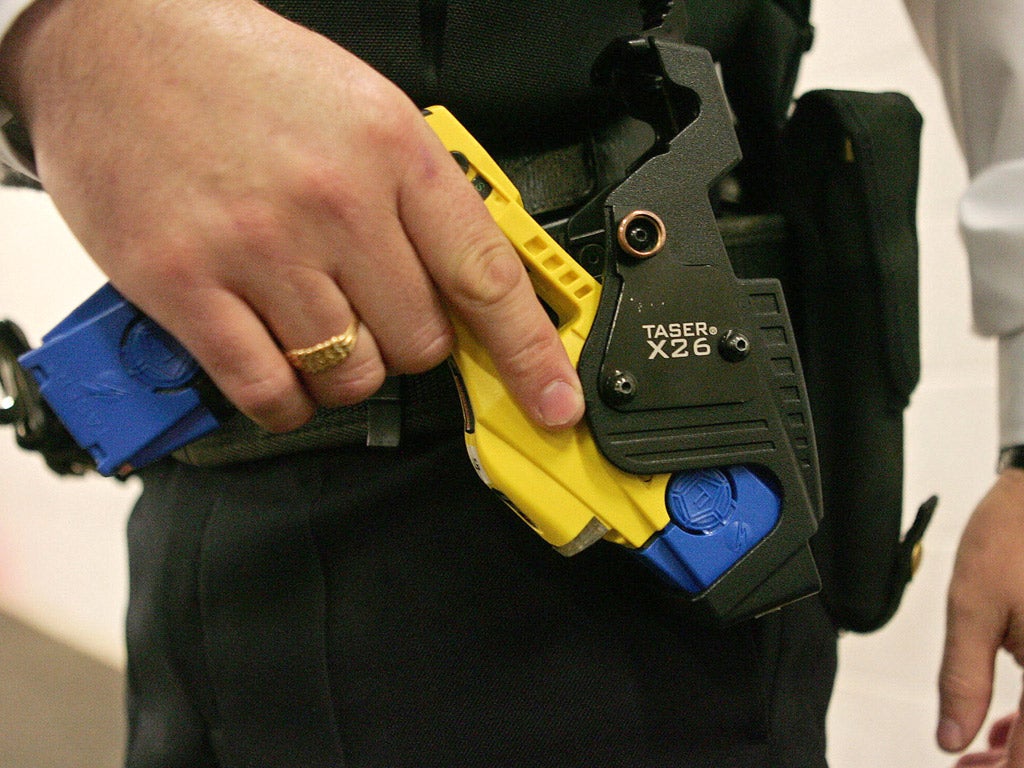Tasers deployed on more than 400 children in a single year by police
David Blunkett, who authorised stun gun’s use, urges review amid concerns of ‘mission creep’

The former Home Secretary who authorised the use of Taser stun guns has called for a review into their use after new figures found that they were deployed on more than 400 children in 2013.
David Blunkett asked for the review after Home Office figures revealed that 431 children were involved in police Taser incidents in 2013, an increase of 37 per cent on the previous year.
The youngest person shot with the 50,000-volt stun gun was 14, research from BBC Radio 5 Live Breakfast found, while police threatened to deploy the weapon on a boy as young as 11.
Mr Blunkett said in the case of the 11-year-old that using a Taser was not “an appropriate way” of dealing with a situation “which clearly must have been out of hand” but where “we need to train people to use more traditional alternatives”.
“This is a moment, perhaps, to take a step back and to get Chief Constables and Police and Crime Commissioners together across England and Wales,” he told the BBC.
He said the inquiry should look at who is authorised to use Tasers, in what circumstances and whether alternatives are available.

It comes after a number of increasingly concerning cases involving young people.
They include Daniel Dove, who was 22 when he was Tasered for flicking his underwear at a police officer during a strip search after he was arrested.
The man described the pain as “like being shocked by a cattle fence but 50,000 times stronger”.
He said he felt like he was paralysed and he seized up. The officer involved was charged with assault and misconduct but was cleared by a jury.
Iain Gould, a solicitor at DPP Law, who specialises in civil actions against police, said he has seen an increase in the inappropriate use of the weapon. He is concerned about “mission creep” and the militarisation of the police.
He said Tasers were deployed to certain trained firearms officers when they were first introduced.
“We now have a situation where rank and file officers are being given Tasers to use,” he said. “My concern is that it has got out of hand and what we are seeing is effectively militarisation by stealth.”
The Association of Chief Police Officers (Acpo) said any use of Tasers has to be justifiable in court.

Commander Neil Basu, Acpo’s lead on the use of Tasers, said: “We have to remember that children can commit violent crime too. The police are paid to intervene in those situations and Taser can be an appropriate use of force.”
Earlier this month, the Police Federation voted for all uniformed officers to be issued with Tasers.
In December, another solicitor called for a temporary ban on the use of Tasers after a man was shot with one during a suspected burglary in Staffordshire. Sophie Khan, a solicitor advocate at Sophie Khan and Associates, said a ban was needed while a government review of their use is taking place.
The death in Newcastle-under-Lyme was the third fatal incident after someone was hit by a Taser.
Home Secretary Theresa May announced the review in October last year. It will assess the use of the stun guns on people with mental health problems and on children.
Tasers – which deliver a 50,000-volt shock to victims, temporarily immobilising them – were only introduced in England and Wales in 2003 for people who presented a risk to police at a time when Mr Blunkett was home secretary.
Home Office figures show the use of the stun guns increased by 13 per cent in 12 months and they were used on 5,107 occasions in England and Wales between January and June 2014.
However, in the majority of cases (81 per cent), they were not fired.
Join our commenting forum
Join thought-provoking conversations, follow other Independent readers and see their replies
Comments